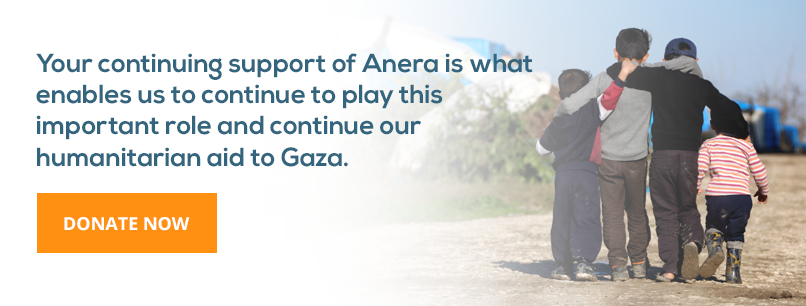Gaza Emergency
Posted in: Life in the Middle East, News
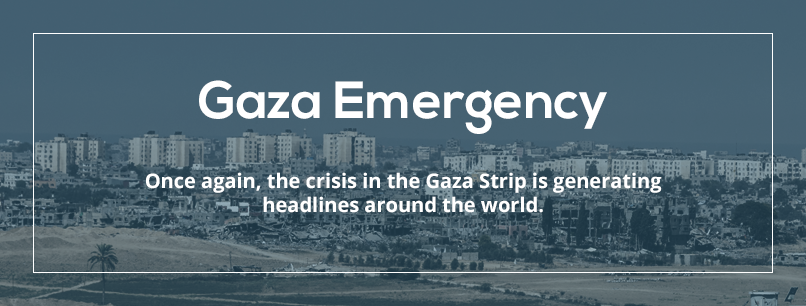
Once again, the crisis in the Gaza Strip is generating headlines around the world. Recent protests at the Gaza-Israeli border left thousands of Palestinians in need of medical aid. These Gaza protests, called ‘The Great March of Return,’ were focused on the right of return for Palestinian refugees and their descendants to family lands or homes lost during the 1948 Arab-Israeli War.
The protests left Gaza hospitals in a state of emergency as they were overwhelmed with civilians in need of medical aid and soon ran short on essential medical supplies. While the Gaza protests have continued, they have been smaller in size but have still resulted daily in casualties that number in the dozens.
The latest Gaza emergency comes only three months after the Gaza municipality declared a state of emergency because of cuts in financial aid that led to severe fuel shortages. The fuel shortage has affected everything from transportation to sanitation. The mayor of Gaza City announced that the entire coast would be closed and that untreated wastewater would be dumped into the Mediterranean because of power shortages.
Where Is Gaza and What Is the Gaza Strip?
The Gaza Strip is located between the country of Israel and the Sinai Peninsula, which is controlled by Egypt. The area known as the Gaza Strip was created during the 1948 Arab-Israeli War. Egyptian forces used the town of Gaza as a base during their conflict with the Israeli army, but by fall of that year, Egypt only controlled an area around the town 25 miles long and five miles wide. When an armistice was reached in 1949, the small patch of land still controlled by the Egyptians became the Gaza Strip. After the 1967 Arab-Israeli War, Israel took control of the Gaza Strip. Then in 1993, under the Oslo Peace Accords, the Palestinian Authority was created and took over control of the Gaza Strip and areas of the West Bank.
Currently, the population of Gaza is around two million people, making it one of the most densely populated areas in the world. And more than 50% of those two million are under the age of 18. There are over 12,350 people packed into every square mile in the Gaza Strip. Gaza City is the 40th most densely populated city in the world. Currently, both Israel and Egypt are blockading the Gaza Strip.
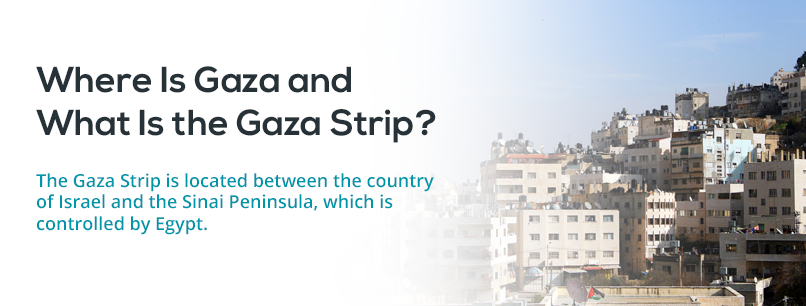
Most citizens enjoy only three to four hours of electricity a day when it is available. It is not unusual, however, for many communities to go days without electricity — a situation made even more urgent during the current financial aid shortages.
Gaza also has the highest unemployment rate in the world, almost 41%. It’s above 60% for those below the age of 29. For many residents of the Gaza Strip, finding even the most basic job to support their families is an almost impossible task.
With so many people packed into such a small space, it makes the humanitarian crisis even more urgent.
Humanitarian Response
Years of conflict and crisis, and the current blockades being carried out by Israel and Egypt, mean that the Gaza Strip is more dependent on foreign aid than it ever has been before. Seventy percent of the population depends on humanitarian aid from foreign governments and non-profit organizations. Earlier this year, however, the United States, which has always been the largest donor of humanitarian aid for Palestinians in the Gaza Strip, withheld $65 million of the $125 million in funding that had previously been pledged to the United Nations Relief and Works Agency (UNRWA). UNRWA helps over five million Palestinian refugees in the region.
While some nations did step forward and immediately donate their entire 2018 contributions to help UNRWA absorb the financial impact of the loss of $65 million, no other nations moved to make up that shortfall over the subsequent few months, which led to the financial crisis in Gaza that we mentioned above.
An emergency conference then held in March 2018 in Rome saw countries donate an additional $100 million to the UNRWA. Countries providing the new aid included Canada, Switzerland, Turkey, Qatar, Mexico, Slovakia, India, New Zealand, Norway, South Korea and France. UNRWA, however, still faces a $350 million shortfall overall.
How Does the Shortfall in Humanitarian Aid Funding Affect the Gaza Strip?
Before the cuts in funds to UNRWA were announced, the economy of the West Bank was already largely decimated by the 10-year long blockade. Exporting what few goods were produced and importing important supplies were both extremely difficult. Even before the most recent Gaza protests, hospitals were already suffering from a lack of the most important medical supplies and medicines.
Essentials like water and electricity have long been in short supply, a situation now exacerbated by the funding emergency. Water problems are particularly acute in the Gaza Strip. Often the water is not potable, and the sanitation problems caused by the electricity shortages mean that many Palestinians live daily with raw sewage in their streets and communities. Even if the electricity was still available, almost a quarter of Palestinians are not connected to a sewage network of any kind. The incidents of diarrhea among children has doubled recently.
A recent UN report noted that almost 110 million liters of untreated sewage is dumped off the coast of Gaza daily, and this was before the current fuel shortages. The report also predicted that if the situation was not resolved, Gaza would be unlivable by the year 2020.
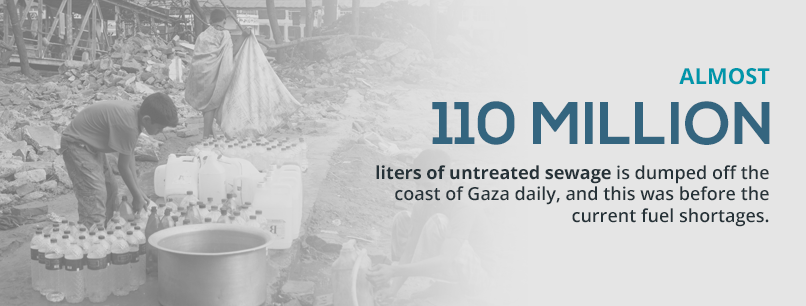
More than 96 percent of the water from the aquifer that Palestinians depend upon is undrinkable because of the salinity of the water. Studies show that if the situation is not improved, the aquifer will become totally unusable by 2020. As a result, residents of the Gaza Strip must have water delivered in trucks. Expensive as this was in the past, it is even more so now because of demand.
The electricity crisis is bad enough on its own, but it only exacerbates the water and sewage crises. We’ve already mentioned above that residents of the Gaza Strip can only count on three to four hours of electricity a day, and sometimes communities can go a week or longer without any electricity. The energy shortages also affect more than 450 water and sewage treatment facilities. Without power, Gaza’s 55 sewage pumping stations will completely stop, and raw sewage could back up into homes and streets.
The recent clashes at the Gaza-Israel border have not only diminished medical supplies in the Gaza Strip but also means that many patients are being sent home before their treatment is finished. Shortages in the hospitals often force patients to buy their own medications to receive treatment.
Yet for all these problems Palestinians in the Gaza Strip still hold out hope that they can create a better life for themselves and their children. The funding and community assistance provided by nonprofit aid agencies like Anera play an important role in helping keep that hope alive.
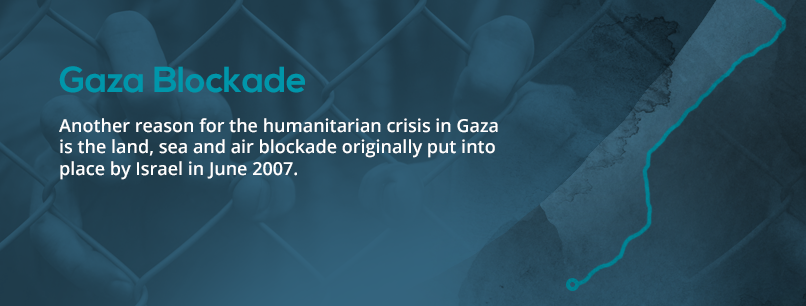
Gaza Blockade
Another reason for the humanitarian crisis in Gaza is the land, sea and air blockade originally put into place by Israel in June 2007. The blockade put stringent controls on what can enter the Gaza Strip. Israel’s stated goal for placing the blockade was to prevent Hamas from getting the materials needed to build rockets and mortars that were hitting Israel. Israel’s other goal was to weaken Hamas politically.
Regardless of the reasons, it has had a devastating effect on the people of the Gaza Strip. While some food and humanitarian supplies are allowed to pass Israeli border checkpoints, it is far from enough to deal with the medical and nutritional needs of the people.
Nonprofit Organizations Play a Key Role
The citizens of Gaza struggle to cope with their current situation, illustrating the need for a generous response from the world community. Along with humanitarian aid sent to Gaza by world governments, many nonprofit humanitarian organizations like Anera are working hard to make an important difference in the Gaza Strip.
Anera is a non-religious, non-political American organization that works with communities in the Gaza Strip, the West Bank and Lebanon. For over five decades, funds donated by Anera supporters mean the organization can focus on helping those affected by conflicts in the region find dignity, purpose and a way forward. The vast majority of our 130+ staff members live and work in the communities they serve. As one of the largest American aid agencies working solely in the Middle East, Anera’s goal is to provide aid for emergency relief as well as for long-term projects in areas like health, education, economic development and water resources.
In 2017, Anera was able to deliver 50 shipping containers of medical supplies and renovate 22 preschools in the Gaza Strip and the West Bank. These are just two of the projects Anera donors were able to complete to help the people of the Gaza Strip.
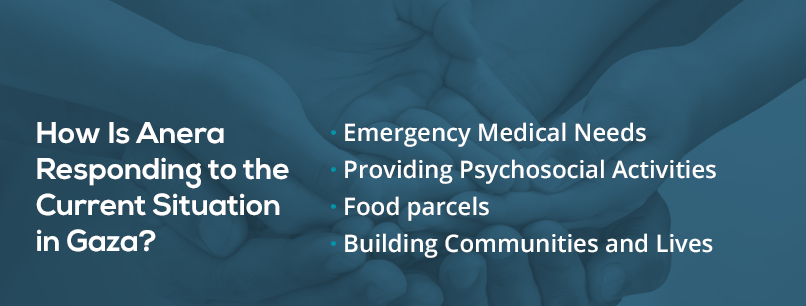
How Is Anera Responding to the Current Situation in Gaza?
Anera, thanks to the help of donors like you, has been able to respond in several effective ways to the current Gaza humanitarian crisis.
- Helping with emergency medical needs: Anera staff members working in Gaza have been able to purchase and deliver much-needed emergency medical supplies such as antibiotics and blood kits. Over 8,700 blood bags have been delivered to Gaza blood clinics. These measures have helped doctors and hospitals treat many of the casualties from the recent protests.
- Providing psychosocial activities to Gaza children: Children are particularly affected by war. Using activities like acting, dancing and drawing, we work to help children release and deal with their anxieties.
- Food parcels: Anera delivered a month’s worth of nutritious food items to more than 2,000 Gaza families.
- Building communities and lives: While responding to the current crisis, in particular the medical needs, Anera continues to be involved with a variety of programs designed to improve the lives of all residents of the Gaza Strip. Our infrastructure projects building reservoirs, sewage systems and community centers are ongoing. We’re helping preschool teachers learn about active learning techniques to improve children’s education. We’re helping owners of small family plots install greenhouses and irrigation systems. We support the Food Bank Center, a women’s co-op that enables its members to build livelihoods and which serves 1,500 children breakfast twice a week.
What Happens When You Donate to Gaza
In spite of the problems faced daily by residents of the Gaza Strip, when you donate to Anera, it helps people live a more dignified life.
- Only 5% of donations go toward Anera’s overhead — the remaining 95% goes directly to the residents of the Gaza Strip, the West Bank and Lebanon.
- These important funds have helped improve the lives of many men, women and children.
- All the projects and community building activities that we initiate or help our partners undertake would be impossible without your generosity and support.
It’s understandable that many residents of Gaza might feel like there is no hope after 10 years of blockade. But organizations like Anera are working hard every day to restore that hope. The work we do with community organizations is essential to the physical and mental well-being of many residents of the Gaza Strip. Our staff of 16 in Gaza, all Palestinians from the communities they serve, can quickly identify the areas that need the most help and take action as soon as the funds are available.
Your continuing support of Anera is what enables us to continue to play this important role and continue our humanitarian aid to Gaza.
When you take that step to donate to our Gaza fund, it means that we continue to supply many of the important items needed during the current emergency. As one of the few relief agencies that can reliably deliver much-needed supplies, Anera can put your donation to work right away, so it has an immediate impact on the situation.
You can also help us in other ways. Anera doesn’t spend a lot of money on advertising like many other nonprofit relief organizations. We depend on our supporters to spread the news of the good work that we do to others who are interested in helping Gaza. Please tell your friends and family members about our work in the region.
You can find out more about our organization, our record of giving and how we ensure that your donations go to legitimate community organizations in our FAQ.
OUR BLOG
Related
In this log, Anera provides updates on unfolding war in Palestine and our response. In some cases, additional activities may be added retroactively to the daily entries as we receive additional program reporting. Questions? See our FAQ page July 10,…

